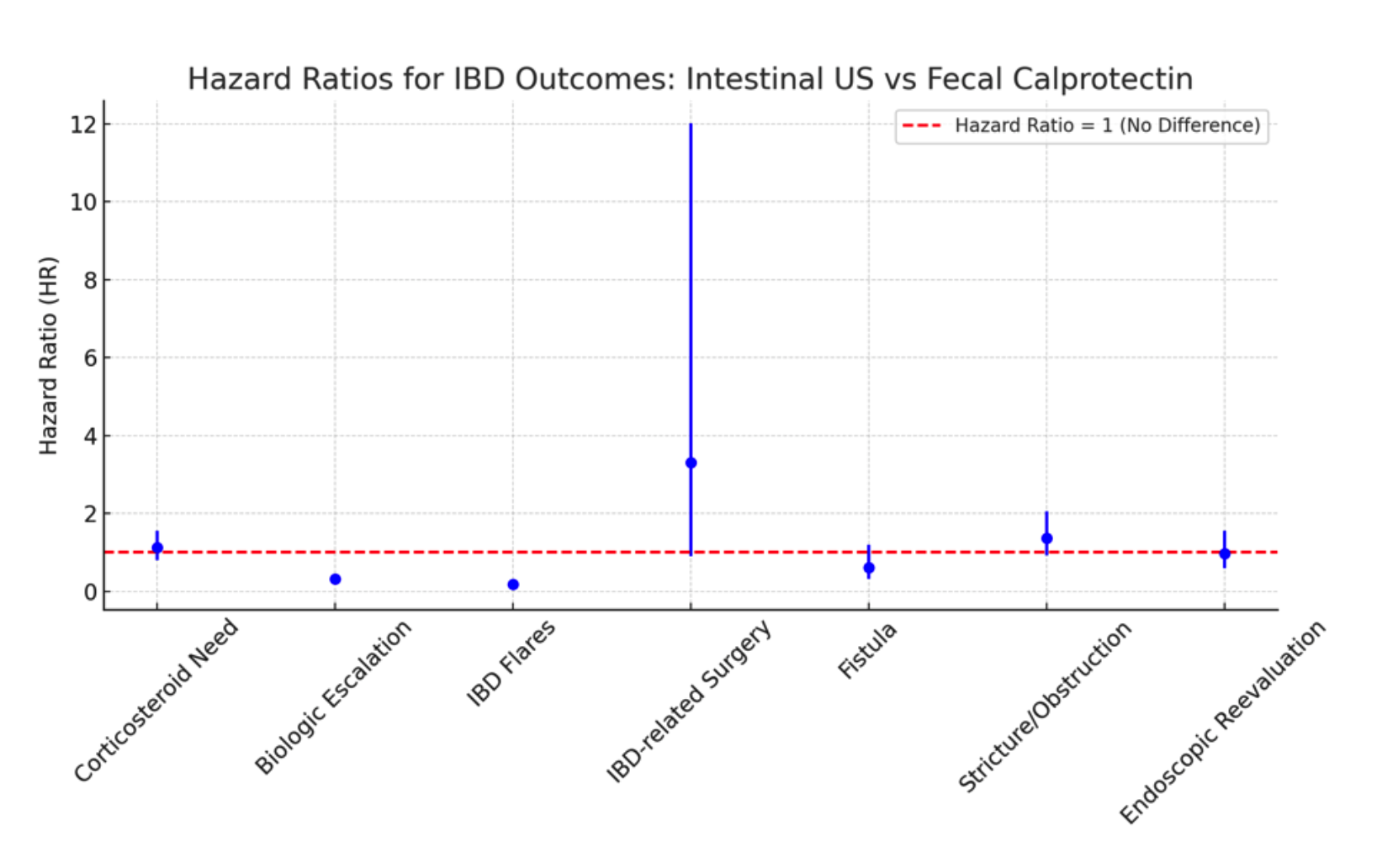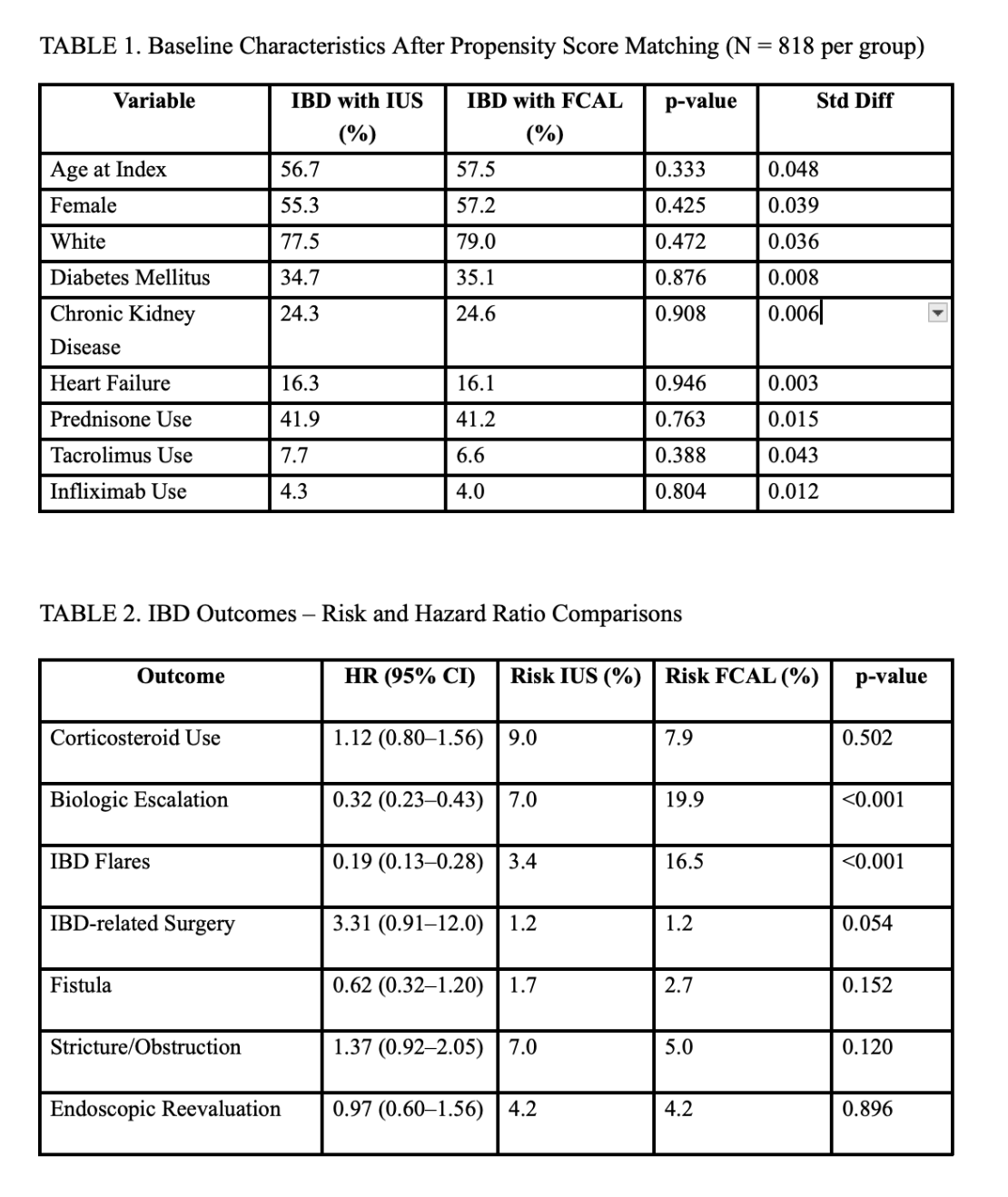Monday Poster Session
Category: IBD
P3183 - Real-World Comparative Outcomes of Intestinal Ultrasound versus Fecal Calprotectin for Monitoring Inflammatory Bowel Disease
Monday, October 27, 2025
10:30 AM - 4:00 PM PDT
Location: Exhibit Hall

Ashujot K. Dang, MD
University of California Riverside School of Medicine
Riverside, CA
Presenting Author(s)
Ashujot K. Dang, MD1, Vikash Kumar, MD2, Aalam Sohal, MD2, Divyesh Sejpal, MD, MS2, Indu Srinivasan, MD2, Wael Youssef, MD2
1University of California Riverside School of Medicine, Riverside, CA; 2Creighton University School of Medicine, Phoenix, AZ
Introduction: Monitoring inflammatory bowel disease (IBD) activity is crucial for guiding treatment decisions. While fecal calprotectin (FCAL) is a widely used non-invasive biomarker, intestinal ultrasound (IUS) has emerged as a rapid, radiation-free imaging modality capable of directly visualizing bowel inflammation. This study compared real-world outcomes in IBD patients monitored using IUS versus FCAL.
Methods: We queried the TriNetX US Collaborative Network to identify adult patients (≥18 years) with Crohn’s disease or ulcerative colitis who underwent either IUS or FCAL. Patients were excluded if they received both tests within the same period. Propensity score matching (1:1) was performed based on demographics, comorbidities, and baseline medication use. Outcomes assessed within one year of testing included corticosteroid use, biologic therapy escalation, IBD flares, surgery, fistula, obstruction, and repeat endoscopy. Risk ratios, odds ratios, and Kaplan-Meier analyses were conducted.
Results: After matching, 818 patients were included in each cohort. Compared to the FCAL group, the IUS group had significantly lower rates of biologic escalation (HR 0.316; 95% CI: 0.234–0.427; p < 0.001) and IBD flares (HR 0.188; 95% CI: 0.125–0.283; p < 0.001). No statistically significant differences were observed in corticosteroid use, surgery, fistula, obstruction, or repeat endoscopy. Further results are depicted in the table below.
Discussion: Use of IUS for IBD monitoring was associated with significantly fewer flares and reduced need for biologic escalation compared to FCAL. These improved outcomes may be attributed to the advantages of IUS; particularly its ability to provide direct visualization of bowel inflammation and immediate, real-time feedback, enabling more timely and targeted clinical decision-making. These findings support broader integration of IUS into routine IBD management pathways.

Figure: Table 1: Baseline Characteristics After Propensity Score Matching (N = 818 per group)
Table 2: IBD Outcomes in IUS vs FCAL patients – Risk and Hazard Ratio Comparisons

Figure: Hazard ratios for IBD outcomes: IUS vs FCAL
Disclosures:
Ashujot Dang indicated no relevant financial relationships.
Vikash Kumar indicated no relevant financial relationships.
Aalam Sohal indicated no relevant financial relationships.
Divyesh Sejpal: Boston Scientific – Consultant. Olympus – Grant/Research Support.
Indu Srinivasan indicated no relevant financial relationships.
Wael Youssef indicated no relevant financial relationships.
Ashujot K. Dang, MD1, Vikash Kumar, MD2, Aalam Sohal, MD2, Divyesh Sejpal, MD, MS2, Indu Srinivasan, MD2, Wael Youssef, MD2. P3183 - Real-World Comparative Outcomes of Intestinal Ultrasound versus Fecal Calprotectin for Monitoring Inflammatory Bowel Disease, ACG 2025 Annual Scientific Meeting Abstracts. Phoenix, AZ: American College of Gastroenterology.
1University of California Riverside School of Medicine, Riverside, CA; 2Creighton University School of Medicine, Phoenix, AZ
Introduction: Monitoring inflammatory bowel disease (IBD) activity is crucial for guiding treatment decisions. While fecal calprotectin (FCAL) is a widely used non-invasive biomarker, intestinal ultrasound (IUS) has emerged as a rapid, radiation-free imaging modality capable of directly visualizing bowel inflammation. This study compared real-world outcomes in IBD patients monitored using IUS versus FCAL.
Methods: We queried the TriNetX US Collaborative Network to identify adult patients (≥18 years) with Crohn’s disease or ulcerative colitis who underwent either IUS or FCAL. Patients were excluded if they received both tests within the same period. Propensity score matching (1:1) was performed based on demographics, comorbidities, and baseline medication use. Outcomes assessed within one year of testing included corticosteroid use, biologic therapy escalation, IBD flares, surgery, fistula, obstruction, and repeat endoscopy. Risk ratios, odds ratios, and Kaplan-Meier analyses were conducted.
Results: After matching, 818 patients were included in each cohort. Compared to the FCAL group, the IUS group had significantly lower rates of biologic escalation (HR 0.316; 95% CI: 0.234–0.427; p < 0.001) and IBD flares (HR 0.188; 95% CI: 0.125–0.283; p < 0.001). No statistically significant differences were observed in corticosteroid use, surgery, fistula, obstruction, or repeat endoscopy. Further results are depicted in the table below.
Discussion: Use of IUS for IBD monitoring was associated with significantly fewer flares and reduced need for biologic escalation compared to FCAL. These improved outcomes may be attributed to the advantages of IUS; particularly its ability to provide direct visualization of bowel inflammation and immediate, real-time feedback, enabling more timely and targeted clinical decision-making. These findings support broader integration of IUS into routine IBD management pathways.

Figure: Table 1: Baseline Characteristics After Propensity Score Matching (N = 818 per group)
Table 2: IBD Outcomes in IUS vs FCAL patients – Risk and Hazard Ratio Comparisons

Figure: Hazard ratios for IBD outcomes: IUS vs FCAL
Disclosures:
Ashujot Dang indicated no relevant financial relationships.
Vikash Kumar indicated no relevant financial relationships.
Aalam Sohal indicated no relevant financial relationships.
Divyesh Sejpal: Boston Scientific – Consultant. Olympus – Grant/Research Support.
Indu Srinivasan indicated no relevant financial relationships.
Wael Youssef indicated no relevant financial relationships.
Ashujot K. Dang, MD1, Vikash Kumar, MD2, Aalam Sohal, MD2, Divyesh Sejpal, MD, MS2, Indu Srinivasan, MD2, Wael Youssef, MD2. P3183 - Real-World Comparative Outcomes of Intestinal Ultrasound versus Fecal Calprotectin for Monitoring Inflammatory Bowel Disease, ACG 2025 Annual Scientific Meeting Abstracts. Phoenix, AZ: American College of Gastroenterology.
